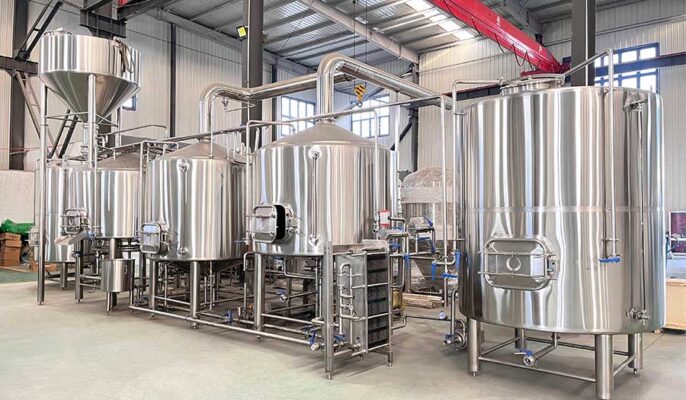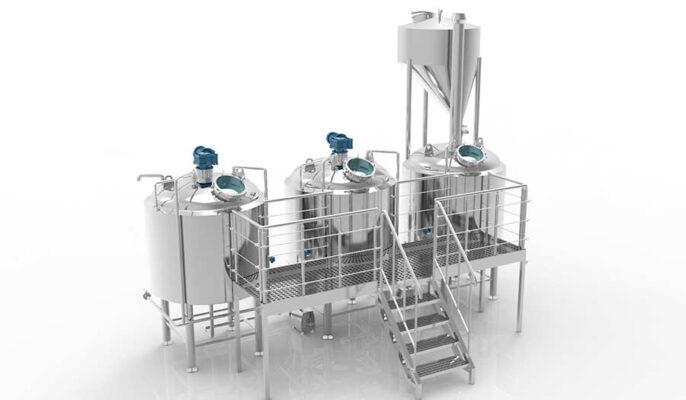양조 업계에서 3-용기 양조 시스템은 효율적이고 유연한 양조 솔루션으로 많은 양조장과 양조업자들이 가장 먼저 선택하는 시스템이 되었습니다. 이 시스템은 맥아즙 배럴, 라우터 툰, 케틀의 세 가지 주요 구성 요소로 이루어져 있습니다. 각 용기는 양조 과정에서 특정한 역할을 수행하므로 양조 과정을 더 잘 제어하고 보다 일관된 최종 제품을 생산할 수 있습니다.
3용기 추출 시스템이란 무엇인가요?
3용기 양조 시스템은 일반적으로 매싱 탱크, 라우터링 탱크, 끓이는 주전자의 세 가지 주요 구성 요소로 이루어져 있습니다. 3용기 양조 시스템의 워크플로우는 원료 준비부터 시작하여 매시, 여과, 끓이기 등 여러 단계를 거쳐 맥아를 알코올 음료로 변환합니다. 각 용기의 역할과 디자인은 매우 중요하며, 함께 양조 공정의 효율성과 안정성을 보장합니다. 3용기 양조 시스템은 전문 홈브루어들을 위한 최고의 장비입니다. 이 시스템은 세 개의 개별 주전자로 구성되며, 각 주전자는 양조 과정에서 중요한 역할을 합니다.
매싱 탱크
- 기능: 분쇄 맥아를 뜨거운 물과 혼합하고 가열하고 저어 전분을 당분으로 전환합니다.
- 과정: 매시 과정에서 맥아에 있는 효소가 전분을 분해하여 발효 가능한 당분을 형성합니다. 이 과정의 온도와 시간을 조절하는 것은 최종 제품의 맛과 품질에 결정적인 영향을 미칩니다.
라우터링 탱크
- 기능: 액체 맥아즙과 고체 잔여물을 분리합니다.
- 과정: 매시 후에는 필터 케틀을 통해 맥아즙을 분리해야 합니다. 고체 찌꺼기는 필터 주전자 바닥에 남고, 맑은 맥즙은 추가 처리를 위해 보일러로 흘러들어갑니다.
끓는 주전자
- 기능: 맥즙을 끓이고 홉을 추가하여 최종 풍미를 조절합니다.
- 과정: 보일러에서 맥즙을 끓는점까지 가열하고 홉을 첨가하여 맥주의 쓴맛과 향을 강화합니다. 또한 끓이면 액체에서 불필요한 성분이 제거되어 맑은 맥주를 만드는 데 도움이 됩니다.

3 베셀의 종류 양조 장비 시스템
- 홈브루 양조 장비: 애호가 및 홈브루어들을 위해 설계된 제품입니다. 크기가 작아 차고나 전용 양조실에 쉽게 설치할 수 있습니다. 홈브루잉은 많은 맥주 애호가들이 집에서 편안하게 소량의 맥주를 직접 양조할 수 있는 창의적인 방법을 제공하는 훌륭한 출발점입니다.
- 나노 양조 시스템: 홈브루잉과 상업용 양조 사이의 가교 역할을 하는 나노브루잉 시스템은 용량은 더 크지만 카페나 실험용 양조 실험실과 같은 작은 공간에 적합합니다. 이러한 시스템은 일반적으로 반자동이며 더 자주 양조하는 데 적합합니다.
- 소규모 양조 장비: 소규모 양조장 또는 수제 맥주 양조장은 홈브루어리보다는 규모가 크지만 상업용 양조장보다는 여전히 작습니다. 고도로 자동화되어 있으며 발효 탱크와 같은 추가 용기를 장착할 수 있습니다.
- 상업용 양조장 시스템: 이 시스템은 대규모 생산을 위해 설계되었으며 대량의 맥주를 생산하는 기존 양조장에서 사용합니다.
- 완전 자동화되고 고급 모니터링 시스템을 갖추고 있으며 일반적으로 양조장의 필요에 따라 맞춤화할 수 있습니다. 상업용 양조장은 규모가 크고 더 넓은 시장에 맥주를 공급합니다.
3 용기 양조 시스템 장비 기능
3용기 양조 시스템은 상업용 또는 가정용 양조에 사용되는 장비로, 맥아, 맥즙, 홉과 같은 원료를 맥주로 전환하는 것이 주요 기능입니다.
매싱 팟
- Wort Tub Starch Conversion: The wort tub is where the ground grains meet the hot water. This interaction activates enzymes in the malt, which convert the grains’ starches into fermentable sugars. This sweet liquid is called wort and is the basis of beer.
- 온도 단계: 일부 양조 레시피는 매싱 단계마다 다른 효소를 활성화하기 위해 서로 다른 온도가 필요합니다. 최신 맥아즙 추출통에는 다단계 매싱을 가능하게 하는 고급 온도 제어 기능이 탑재되어 있습니다.
필터 탱크
- 곡물에서 맥아즙 분리하기: 매싱이 완료되면 맥아즙을 곡물 바닥에서 분리해야 합니다. 필터 탱크의 바닥에는 고체 곡물층을 유지하면서 액체 맥즙이 통과할 수 있는 슬롯 플레이트가 있습니다.
- 헹구기: 뜨거운 물로 곡물 층을 씻어내어 남아있는 당분을 추출하는 과정입니다. 필터 탱크는 뜨거운 물을 곡물 층에 고르게 분배하여 헹굼을 용이하게 합니다.
끓는 주전자
- 홉을 끓이고 추가합니다: 수집한 맥즙을 끓는 주전자에 넣고 끓입니다. 맥주에 쓴맛, 풍미, 향을 더하기 위해 끓이는 과정의 여러 단계에서 홉을 첨가합니다.
- 살균: 끓는 맥아즙에는 살균이라는 또 다른 핵심 기능이 있습니다. 끓이는 과정에서 유해한 미생물이 모두 파괴되어 이후 깨끗한 발효를 보장합니다.
- 소용돌이 형성: 일부 끓는 주전자에는 액체가 순환하여 소용돌이를 형성하는 월풀 기능이 있습니다. 이렇게 하면 중앙에 고체 입자가 가라앉아 측면에서 맑은 맥아즙을 더 쉽게 추출할 수 있습니다.

3용기 브루잉 시스템 비용은 얼마인가요?
The cost of a three-vessel brewing system can vary greatly depending on several factors. These factors include the system’s capacity, materials, level of automation, brand, and additional features. Whether you are a home brewer or a commercial brewer, understanding the cost structure is critical to making an informed decision.
|
시스템 용량 |
가격 범위 |
|
5갤런 |
$500 - $1,500 |
|
10 갤런 |
$1,500 - $3,500 |
|
1 BBL(31갤런) |
$5,000 – $10,000 |
|
BBL 5개(155갤런) |
$20,000 - $40,000 |
|
BBL 10개(310갤런) |
$40,000 – $80,000 |
- 크기/용량: 세 개의 용기로 구성된 양조 시스템은 몇 갤런의 소규모 홈메이드 설정부터 수천 갤런을 자연적으로 생산할 수 있는 대형 상업용 시스템까지 다양합니다.
- 재질: 스테인리스 스틸은 내구성이 뛰어나고 부식에 강하며 세척이 쉽기 때문에 가장 일반적으로 사용되는 소재입니다. 하지만 스테인리스 스틸의 품질과 두께는 다양하므로 가격에 영향을 미칠 수 있습니다.
- 자동화: 전자 제어, 펌프, 전동 밸브를 포함하는 자동화 시스템은 수동 시스템보다 비용이 더 많이 듭니다. 하지만 더 높은 정밀도와 사용 편의성을 제공합니다.
- 추가 기능: 일부 시스템에는 통합 열교환기, 고급 온도 제어, 곡물 분쇄기 등의 추가 기능이 제공됩니다. 이러한 각 기능은 비용을 증가시킬 수 있습니다.
- 설치 및 교육: 많은 제조업체에서 설치 서비스 및 교육 과정을 제공합니다. 이렇게 하면 초기 투자 비용이 증가할 수 있지만, 시스템이 올바르게 설정되고 사용자 또는 팀이 시스템을 효과적으로 운영하는 방법을 알 수 있습니다.
3용기 양조 장비는 어떻게 선택하나요?
- 양조 목표를 명확히 합니다: 양조할 맥주의 양을 고려하세요. 가정용 양조는 일반적으로 20~200L를 선택하지만 상업용 양조장에서는 더 큰 시스템 크기가 필요합니다.
- 재료 선택: 대부분의 고품질 3용기 시스템은 부식에 강하고 내열성이 있으며 세척이 쉬운 스테인리스 스틸을 사용합니다. 일부 보급형 시스템은 알루미늄이나 기타 재료를 사용할 수 있는데, 이는 가격은 저렴하지만 스테인리스 스틸만큼 내구성이 뛰어나지 않습니다.
- 공간 고려 사항: 크기와 공간은 매우 중요합니다. 추출 공간을 측정하여 수용 가능한 최대 시스템 크기를 결정하세요. 이동, 보관 및 기타 브루잉 액세서리를 위한 추가 공간도 고려하세요.
- 사용자 지정 옵션: 일부 제조업체는 사용자 지정 옵션을 제공합니다. 센서 추가를 위한 포트 추가부터 시스템 외관 맞춤 설정까지, 이러한 옵션을 통해 나만의 독특한 브루잉 시스템을 만들 수 있습니다.
- 유지 관리: 정기적인 유지보수는 브루잉 시스템의 수명과 성능에 필수적입니다. 청소와 유지 관리가 쉬운 시스템을 선택하세요.
- 보증 및 지원: 제조업체가 제공하는 보증 및 판매 후 지원을 고려하세요. 좋은 보증은 제조업체가 제품에 자신감을 가지고 있다는 것을 보여주며, 강력한 지원은 문제가 발생했을 때 도움을 받을 수 있도록 보장합니다.
- 공급업체의 평판: 공급업체의 평판에 특히 주의하세요. 다른 양조업체가 관련 문제에 대한 인사이트를 제공할 수 있습니다.
자주 묻는 질문
3용기 추출 시스템이란 무엇인가요?
3용기 양조 시스템은 맥주 양조에 사용되는 장비의 일종으로, 세 개의 주요 용기를 포함합니다: 매싱 케틀, 로더 툰, 끓이는 케틀입니다. 각 용기의 기능은 매싱, 필터링, 끓이기입니다.
3용기 브루잉 시스템의 가격대는 어떻게 되나요?
구체적인 가격은 구체적인 양조 요구 사항에 따라 다르며, 대략적인 금액은 다음과 같습니다:
- 엔트리 레벨 시스템: $300-$800
- 미드레인지 시스템: $800-$2,000
- 하이엔드 시스템: $2,000-$5,000 이상
3용기 추출 시스템과 싱글 포트 시스템의 차이점은 무엇인가요?
3용기 시스템은 매싱, 여과, 끓이기 전용 용기가 3개로 구성되어 있어 제어 정확도와 효율성이 더 높습니다. 단일 포트 시스템(예: 단일 포트 매싱 시스템)은 이러한 단계를 하나의 포트에 집중하여 작동하기는 더 간단하지만 3용기 시스템만큼 효율적이고 제어하기는 어려울 수 있습니다.
냉각 장치를 설치해야 하나요?
예, 냉각 장치(예: 냉각 코일 또는 스프레이 쿨러)는 끓인 맥아즙을 발효에 필요한 온도로 빠르게 식혀 박테리아 오염과 과열을 방지하는 데 매우 중요합니다.




